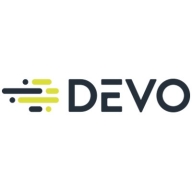

IBM Turbonomic and Devo compete in the IT optimization and analytics category. Turbonomic seems to have the upper hand due to its broader feature set including robust automation and planning capabilities in areas critical for IT environment optimization.
Features: IBM Turbonomic is known for its robust automation, planning capabilities, and forecasting tools that significantly aid in VM rightsizing and workload placement. It also excels in capacity management and hardware planning, enhancing IT environments. Devo shines with its high-speed search capabilities, interactive Activeboards for data visualization, and real-time analytics which are crucial for security-related data management.
Room for Improvement: IBM Turbonomic could enhance its dashboard interface and reporting features, as users have highlighted a need for UI modernization and better documentation. Devo faces challenges with its native parsers and pre-built monitoring capabilities, with suggestions for wider integration with third-party applications and improvements to basic reporting functionalities.
Ease of Deployment and Customer Service: IBM Turbonomic receives praise for its efficient on-premises deployments and exceptional customer and technical support. Devo is favored for public and hybrid cloud environments and is also commended for its responsive and knowledgeable support, though there are occasional delays in ticket resolutions. Both companies maintain high standards in customer service.
Pricing and ROI: IBM Turbonomic offers competitive pricing with quick ROI, attributed mainly to cost savings from workload optimization and capacity planning. Devo's pricing is based on data ingestion and, while straightforward, can entail unexpected costs due to metadata charges. Nevertheless, Devo's pricing is often regarded as providing good value against competitors, with both platforms delivering significant ROI through enhanced operational efficiency and cost management.


Devo is the only cloud-native logging and security analytics platform that releases the full potential of all your data to empower bold, confident action when it matters most. Only the Devo platform delivers the powerful combination of real-time visibility, high-performance analytics, scalability, multitenancy, and low TCO crucial for monitoring and securing business operations as enterprises accelerate their shift to the cloud.
IBM Turbonomic offers automation, planning, and right-sizing recommendations to streamline resource management, improve efficiencies, and optimize costs across virtualized environments and cloud platforms.
IBM Turbonomic is valued for its capability to optimize resource allocation and monitor virtual environments efficiently. It facilitates automated decision-making in VM sizing, load balancing, and cost optimization for both on-premises and cloud deployments. Users can leverage insights for workload placement, ensure peak performance assurance, and effectively right-size across VMware and Azure. The ongoing transition to HTML5 aims to improve visual and navigational ease, while expanded reporting features are anticipated. Opportunities for improved training, documentation, and integrations enhance platform usability and functionality.
What Are the Key Features?In finance, IBM Turbonomic aids in maintaining platform efficiency during market fluctuations. Healthcare organizations leverage its capability for resource optimization during high-demand periods to enhance patient care support. Retailers use it for planning in peak seasons, ensuring resources align with fluctuating demand to maintain performance continuity.
We monitor all AIOps reviews to prevent fraudulent reviews and keep review quality high. We do not post reviews by company employees or direct competitors. We validate each review for authenticity via cross-reference with LinkedIn, and personal follow-up with the reviewer when necessary.